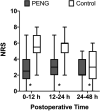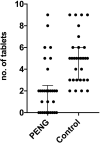Impact of the pericapsular nerve group (PENG) block on postoperative analgesia and functional recovery following total hip arthroplasty: a randomised, observer-masked, controlled trial
- PMID: 34196965
- PMCID: PMC8519088
- DOI: 10.1111/anae.15536
Impact of the pericapsular nerve group (PENG) block on postoperative analgesia and functional recovery following total hip arthroplasty: a randomised, observer-masked, controlled trial
Abstract
The pericapsular nerve group (PENG) block is a novel regional anaesthesia technique that aims to provide hip analgesia with preservation of motor function, although evidence is currently lacking. In this single-centre, observer-masked, randomised controlled trial, patients undergoing total hip arthroplasty received pericapsular nerve group block or no block (control group). Primary outcome measure was maximum pain scores (0-10 numeric rating scale) measured in the first 48 h after surgery. Secondary outcomes included postoperative opioid consumption; patient mobilisation assessments; and length of hospital stay. Sixty patients were randomly allocated equally between groups. The maximum pain score of patients receiving the pericapsular nerve group block was significantly lower than in the control group at all time-points, with a median (IQR [range]) of 2.5 (2.0-3.7 [0-7]) vs. 5.5 (5.0-7.0 [2-8]) at 12 h; 3 (2.0-4.0 [0-7]) vs. 6 (5.0-6.0 [2-8]) at 24 h; and 2.0 (2.0-4.0 [0-5]) vs. 3.0 (2.0-4.7 [0-6]) at 48 h; all p < 0.001. Moreover, the pericapsular nerve group showed a significant reduction in opioid consumption, better range of hip motion and shorter time to ambulation. Although no significant difference in hospital length of stay was detected, our results suggest improved postoperative functional recovery following total hip arthroplasty in patients who received pericapsular nerve group block.
Trial registration: ClinicalTrials.gov NCT04306133.
Keywords: anaesthesia; analgesia; arthroplasty; hip surgery; postoperative pain.
© 2021 The Authors. Anaesthesia published by John Wiley & Sons Ltd on behalf of Association of Anaesthetists.
Figures




Comment in
-
Pericapsular nerve group block in hip arthroplasty.Anaesthesia. 2022 Mar;77(3):358. doi: 10.1111/anae.15648. Epub 2021 Dec 16. Anaesthesia. 2022. PMID: 34919738 No abstract available.
References
-
- Shan L, Shan B, Graham D, Saxena A. Total hip replacement: a systematic review and meta‐analysis on mid‐term quality of life. Osteoarthritis Cartilage 2014; 22: 389–406. - PubMed
-
- Young AC, Buvanendran A. Pain management for total hip arthroplasty. Journal of Surgical Orthopaedic Advances 2014; 23: 13–21. - PubMed
-
- Tran DQ, Salinas FV, Benzon HT, Neal JM. Lower extremity regional anesthesia: essentials of our current understanding. Regional Anesthesia and Pain Medicine 2019; 44: 143–80. - PubMed
-
- Hogan MV, Grant RE, Lee L Jr. Analgesia for total hip and knee arthroplasty: a review of lumbar plexus, femoral, and sciatic nerve blocks. American Journal of Orthopedics 2009; 38: E129–E133. - PubMed
Publication types
MeSH terms
Substances
Associated data
LinkOut - more resources
Full Text Sources
Medical

